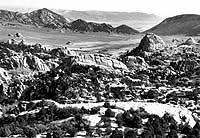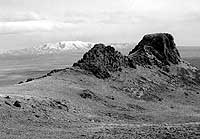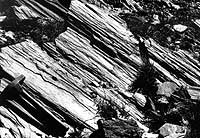Sublett
Range
The Sublett
Range west of Rockland Valley is composed of upper Paleozoic sedimentary rocks,
mainly limestone, from which many fossil corals and other invertebrates can be
collected. Because the bedrock is limestone, surface water is sparse, since water
sinks into underground channels.
Cotterel
and the Jim Sage Mountains
The Jim
Sage mountains west of Raft River Valley contain several tilted Miocene rhyolite
lava flows and ash-flow tuffs. They are best known for rattlesnakes and obsidian.
Settlement
of the Cassia County Area
The first
settlers to Cassia County area were Mormon emigrants from northwestern Utah,
who came in the early 1870s. Beecherville (now Elba, named after the Mediterranean
island where Napoleon had been in exile) was founded on upper Cassia Creek,
eighteen miles east of Oakley, in 1873. Almo was founded in 1878 and named Alamo,
after the great cottonwoods that grew there. The name became shortened to Almo.
|
Mary Jane Gorringe
Tolman, quoted in Arrington (1979, p. 38-39) speaks of Mormon cooperative
farming in the Oakley area in the 1880s.
"In
the spring we were very desirous of planting some crop, but could see
no way out only to put our trust in the One who rules over us. At morning
and evening in our prayers, we petitioned our Father in Heaven to help
us...While my husband was in Oakley, a Brother William Whittle came
to him and said, "Brother Tolman, do you need a little money to
help you put your crop in? If so, I have $10 I can loan you till fall."
A brother C.H. Carlson came to him and said, "I understand you
have no team. You can take my team to put your crop in." My husband
came home rejoicing. We felt that God had been good to us."
|
Albion
Albion,
at the foot of the range that bears its name, was called Marsh Valley and used
by cattlemen in the 1860s. It was settled in 1869 and was county seat of Cassia
County from 1879 to 1919.
In the 1890s, J.E. Miller,
one of Albion's Pioneers, gave 5 acres of land for a Normal School. In 1893, Idaho's
second legislature established 2 normal schools, one of which was at Albion. The
college was closed in a cost-cutting move in 1952. Its fine buildings stand today,
in a state of purgatory between destruction and restoration.
top


